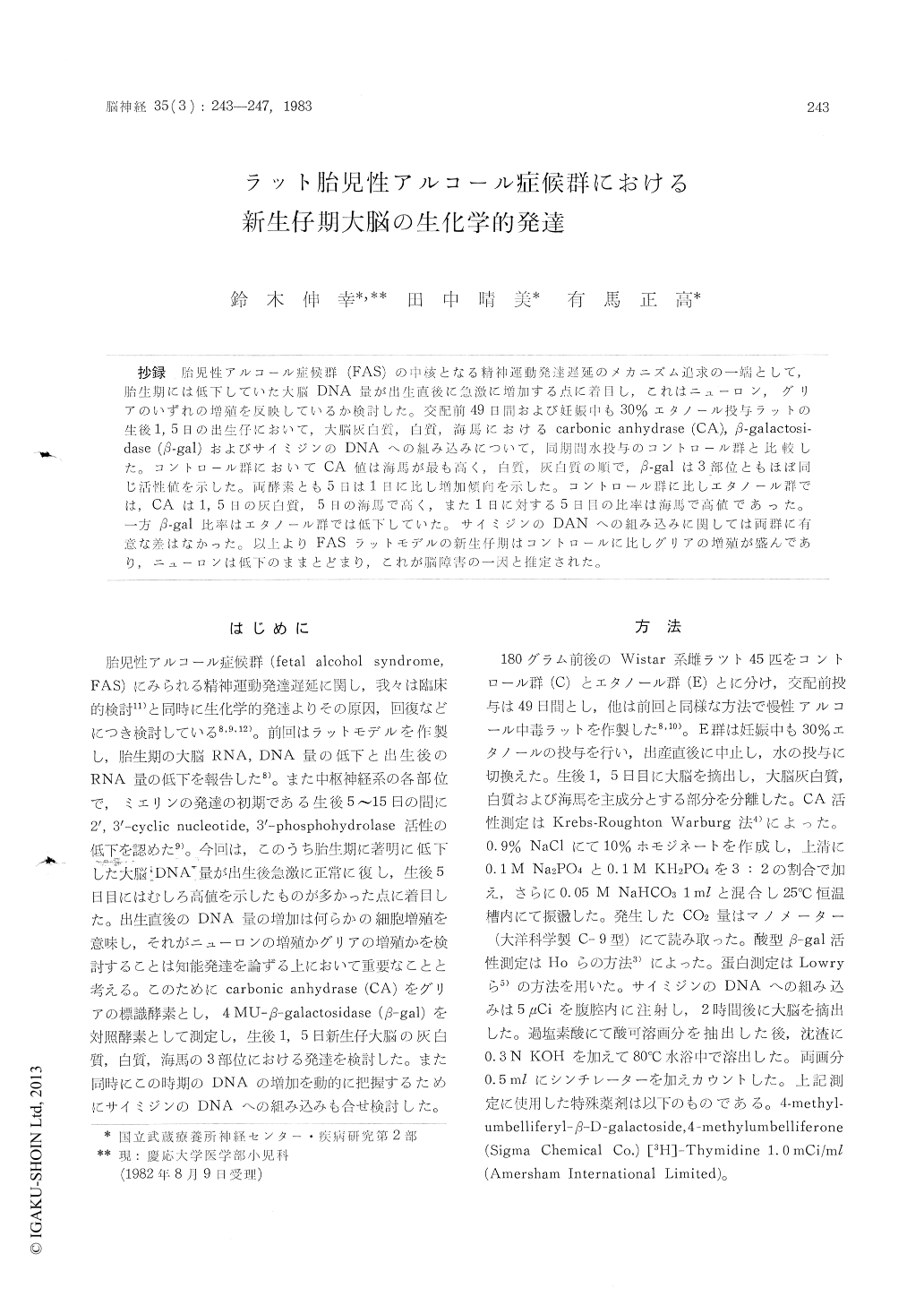Japanese
English
- 有料閲覧
- Abstract 文献概要
- 1ページ目 Look Inside
抄録 胎児性アルコール症候群(FAS)の中核となる精神運動発達遅延のメカニズム追求の一端として,胎生期には低下していた大脳DNA量が出生直後に急激に増加する点に着目し,これはニューロン,グリアのいずれの増殖を反映しているか検討した。交配前49日間および妊娠中も30%エタノール投与ラットの生後1,5日の出生仔において,大脳灰白質,白質,海馬におけるcarbonic anhydrase (CA),β—galactosi—dase (β—gal)およびサイミジンのDNAへの組み込みについて,同期間水投与のコントロール群と比較した。コントロール群においてCA値は海馬が最も高く,白質,灰白質の順で,β—galは3部位ともほぼ同じ活性値を示した。両酵素とも5日は1日に比し増加傾向を示した。コントロール群に比しエタノール群では,CAは1,5日の灰白質,5日の海馬で高く,また1日に対する5日目の比率は海馬で高値であった。一方β—gal比率はエタノール群では低下していた。サイミジンのDANへの組み込みに関しては両群に有意な差はなかった。以上よりFASラットモデルの新生仔期はコントロールに比しグリアの増殖が盛んであり,ニューロンは低下のままとどまり,これが脳障害の一因と推定された。
In previous report we showed that cerebral DNA content in fetus of the fetal alcohol syndro-me (FAS) in rat was low but showed rapid in-crease after birth compared to control. In order to study the cause of the phenomenal catch-up of the number of cells in the brain of FAS, attempts were made to investigate biochemically the neu-ronal and glial development in the neonatal pe-riod of experimental rat model.
Female Wistar rats were divided into ethanol and control groups. Before mating for 49 days and during pregnancy, the ethanol and control groups received 30% ethanol and water, respectively. After pregnancies were terminated by spontane-ous delivery, dams of both groups received water. Offspring on the first and 5th days after birth was weighed and examined for carbonic anhy-drase, β-galactosidase and thymidine incorpora-tion into cerebral DNA in gray matter, white matter and hippocampal area. Carbonic anhydrase activity was measured by the method of Krebs-Roughton Warburg. β-Galactosidase activity was determined with 4-methylumbelliferyl β-galacto-side as the substrate as described by Ho et al. 〔3H〕-Thymidine incorporation into cerebral DNA was carried out by intraperitoneal injection.
In control group, the activity of carbonic anhyd-rase was higher in hippocampus and lower in gray matter in both the first and 5th days after birth, but that of /3-galactosidase showed the almost same values in three areas. The activities of carbonic anhydrase and /3-galactosidase were separated into both high and both low groups in the ethanol group in gray matter and hippocam-pus cn the first day and in hippocampus on the 5th day after birth. The ethanol group showed the high carbonic anhydrase activity on the 5th day in hippocampus compared to control. The ra-tios of values on the first to 5th day after birth of the activity of carbonic anhydrase were higher in the ethanol group than in control group in hip-pocampus, but that of 8-galactosidase was lower in all three areas. There was no significant diffe-rence between both groups about the thymidine incorporation into DNA in gray matter, white matter and hippocampus. The ratios of values on the first to 5th day after birth of the incorpo-ration into cerebral DNA showed the higher tend-ency in the ethanol group than in control, in gray and white matters.
In summary, the activity of carbonic anhydrase in hippocampus was increased in the neonatal pe-riod of the FAS of rats. If the activity of carbo-nic anhydrase reflects glial proliferation, this re-sult shows that increased cerebral DNA content in neonatal period of the FAS of rats means glial, but not neuronal proliferations. As the one cause of mental retardation in FAS, neuronal loss in the central nervous system, especially in hip-pocampus may be speculated.

Copyright © 1983, Igaku-Shoin Ltd. All rights reserved.


